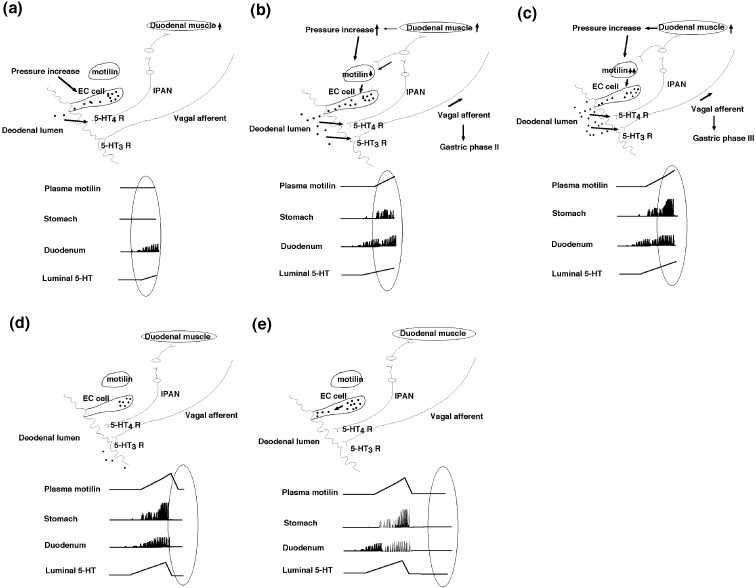Fig. 2.
A possible mechanism of MMC during gastric phase I/duodenal phase II (a), gastric phase II/duodenal phase III (b), gastric/duodenal phase III (c), gastric/duodenal phase IV (d), and gastric/duodenal phase I (e). Plasma motilin levels, gastroduodenal contractions, and luminal 5-HT content in the duodenum in each phase are marked by oval-shaped circles. During phase I of GI tract, gastric, pancreatic and biliary juices are spontaneously secreted. Increased luminal pressure of the duodenum can stimulate 5-HT release from EC cells. Released 5-HT initiates duodenal phase II via 5-HT4 receptors of IPAN (a). Duodenal phase II causes increase of duodenal pressure, which further stimulates the release of 5-HT. This positive circuit (pressure increase and 5-HT release) gradually enhances the amplitude of duodenal phase II, leading to duodenal phase III. Finally, maximally increased duodenal pressure stimulates motilin release (b). Released motilin stimulates large amounts of 5-HT release which acts on 5-HT3 receptors of vagal afferent, in addition to 5-HT4 receptors of IPAN. Released motilin induces gastric phase II and III via vago-vagal reflex (c). Maximally released motilin by a positive feedback depletes 5-HT granules in the duodenal EC cells. Intraluminally released 5-HT are expelled distally during phase III of GI tract and no more present in the duodenal lumen, resulting in no more contractions (d). During phase I of GI tract, 5-HT granules are moving toward from the basolateral to apical cytoplasm, preparing for the next phase II of the duodenum (e). It may take time (for 40–60 min) to accumulate spontaneous gastric, pancreatic, and biliary secretion for increasing intaduodenal pressure, which leads to induce luminal release of 5-HT.

